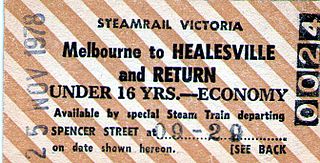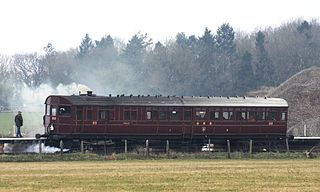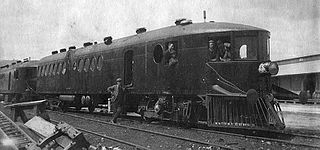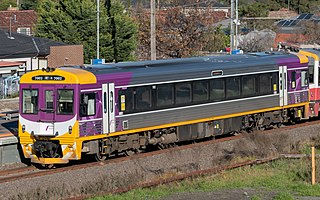| Kerr Stuart steam motor car | |||||||||||||||||||||||||||||
|---|---|---|---|---|---|---|---|---|---|---|---|---|---|---|---|---|---|---|---|---|---|---|---|---|---|---|---|---|---|
 Kerr Stuart steam railmotor in 1913 | |||||||||||||||||||||||||||||
| |||||||||||||||||||||||||||||
| |||||||||||||||||||||||||||||
| |||||||||||||||||||||||||||||
| |||||||||||||||||||||||||||||
The Kerr Stuart steam railmotor, also known as Motor Car 3, was a steam railcar operated by the Victorian Railways from 1913 to 1924.
| Kerr Stuart steam motor car | |||||||||||||||||||||||||||||
|---|---|---|---|---|---|---|---|---|---|---|---|---|---|---|---|---|---|---|---|---|---|---|---|---|---|---|---|---|---|
 Kerr Stuart steam railmotor in 1913 | |||||||||||||||||||||||||||||
| |||||||||||||||||||||||||||||
| |||||||||||||||||||||||||||||
| |||||||||||||||||||||||||||||
| |||||||||||||||||||||||||||||
The Kerr Stuart steam railmotor, also known as Motor Car 3, was a steam railcar operated by the Victorian Railways from 1913 to 1924.
The engine unit was ordered in April 1912 from Kerr, Stuart and Company [1] It was of the same type used on steam railcars of the Great Western Railway. [2] [3] The engine unit was delivered to Melbourne on 24 November 1912. [3]
The body was constructed by the Victorian Railways at Newport Workshops. The body was supported on the power bogie by four vertical links in the same style as the Great Western Railway steam railcars. [2] It was designated Motor Car 3 (following on from the Rowan steam railmotors which were Motors No. 1 and No. 2) and entered service in June 1913. [2] It could carry 27 first class and 27 second class passengers, using seats from the contemporary Tait trains. [1]
Motor Car 3 made its first run on 25 January 1913 and commenced regular testing the following month. [4] It entered service on 5 March 1913 between Warrnambool and Hamilton. [5] It was unable to accommodate the number of passengers and a trailer car for 30 passengers was attached. The additional weight of the trailer car resulted in it running late on every trip and requiring water every 18 miles. [6] By late April 1913 the new steam car had failed and had to be returned to Newport for repairs. [7]
From May 1913, it operated between Maryborough and St Arnaud, initially as a temporary measure to replace a McKeen railmotor and permanently from April 1914. [8] [9]
From January 1915, it operated local services between Ballan and Ballarat. [10] However it suffered frequent breakdowns and accommodation for passengers and luggage was often inadequate. [11]
By 1922, the cost of operating the one-carriage steam car proved to be more expensive than the new petrol cars. [12] Motor Car 3 was withdrawn in 1924 [2] after travelling 50,000 miles (80,000 km) in service and was scrapped in 1927. [13]

A railcar is a self-propelled railway vehicle designed to transport passengers. The term "railcar" is usually used in reference to a train consisting of a single coach, with a driver's cab at one or both ends. Some railway companies, such as the Great Western, termed such vehicles "railmotors".

The Healesville railway line, in Melbourne, Australia, was the non-electrified continuation of the suburban Lilydale line, extending into the Yarra Valley. The line closed in the 1980s, but a heritage railway group, the Yarra Valley Railway, is working to retain part of the line between Yarra Glen and Healesville.
Railmotor is a term used in the United Kingdom and elsewhere for a railway lightweight railcar, usually consisting of a railway carriage with a steam traction unit, or a diesel or petrol engine, integrated into it.
The railways of New South Wales, Australia, use a large variety of passenger and freight rolling stock. The first railway in Sydney was opened in 1855 between Sydney and Granville, now a suburb of Sydney but then a major agricultural centre. The railway formed the basis of the New South Wales Government Railways. Passenger and freight services were operated from the beginning. By 1880, there was a half hourly service to Homebush.

The steam rail motors (SRM) were self-propelled carriages operated by the Great Western Railway in England and Wales from 1903 to 1935. They incorporated a steam locomotive within the body of the carriage.

The McKeen Railmotor was a 6-cylinder self-propelled railcar or railmotor. When McKeen Company of Omaha, Nebraska, U.S.A., first unveiled the car in 1905, the McKeen was among the first engines with a distillate-fueled motor. Revisions to the McKeen car led to the modern self-propelled gasoline rail-motor vehicle, and the "contours of the porthole windows, the front-mounted gasoline engines, and other features anticipated the streamline concept."

The Diesel Electric Rail Motor (DERM) was a railmotor operated by the Victorian Railways of Australia.

The DRC was a class of railmotor operated by the Victorian Railways on its country rail network in Victoria, Australia. The cars were built by Tulloch Limited in New South Wales, and featured aluminium and steel construction, air-conditioning, and twin diesel engines with hydraulic transmissions.

The Sprinter is a diesel railcar built by A Goninan & Co in Broadmeadow for V/Line between 1993 and 1995.
The MT type carriages were railmotor trailers, used on the Victorian Railways (VR) in Australia.
The New Deal for Country Passengers was a timetable introduced on 4 October 1981 in Victoria, Australia which revolutionised the provision of country passenger railway services. Thirty-five little-used passenger stations were closed, rolling stock utilisation was improved, and new rolling stock introduced. The timetable and associated service changes resulted in an average patronage growth of 8.7% per year, from 3 million in 1981 to 5.6 million passengers in 1990/91.

The family of Walker railmotors were a type of diesel railcar operated by the Victorian Railways in Australia.
This article contains information on Victorian Railways vehicles that do not fit into other categories. These were for the most part "one-offs", and many were not even classed.

Tulloch Limited was an Australian engineering and railway rolling stock manufacturer, located at Rhodes, New South Wales.

The South Australian Railways Model Brill railcar were two types of railcars operated by the South Australian Railways between 1925 and 1971. Introduced to run on country rail services, the "Barwell Bulls" serviced most of the state's railway lines until they were eventually replaced by both the Bluebird and Redhen railcars, with the last units withdrawn in 1971.

Diesel multiple units and railcars are trains, usually with passenger accommodation, that do not require a locomotive. Railcars can be single cars, while in multiple units cars are marshalled together with a driving position either end. As of December 2010, 23 percent of the rail passenger cars used on Network Rail are part of a diesel multiple unit.

A steam railcar is a rail vehicle that does not require a locomotive as it contains its own steam engine. The first steam railcar was an experimental unit designed and built in 1847 by James Samuel and William Bridges Adams. In 1848, they made the Fairfield steam carriage that they sold to the Bristol and Exeter Railway, who used it for two years on a branch line.

A steam railcar, steam motor car (US), or Railmotor (UK) is a railcar that is self powered by a steam engine. The first steam railcar was an experimental unit designed and built in 1847 by James Samuel and William Bridges Adams in Britain. In 1848 they made the Fairfield steam carriage that they sold to the Bristol & Exeter Railway, who used it for two years on a branch line.

The railmotors of J. WeitzerEngine- & Waggon-Building & Iron Casting Joint-stock Company were Europe's first self-propelled railcars with internal combustion engine built in considerable numbers. The principle of their petrol–electric transmission and the four-cylinder petrol engines came from De Dion-Bouton in France. The electric engines were produced Siemens-Schuckert in Germany.

The Rowan steam railmotor was a steam railcar operated by the Victorian Railways.